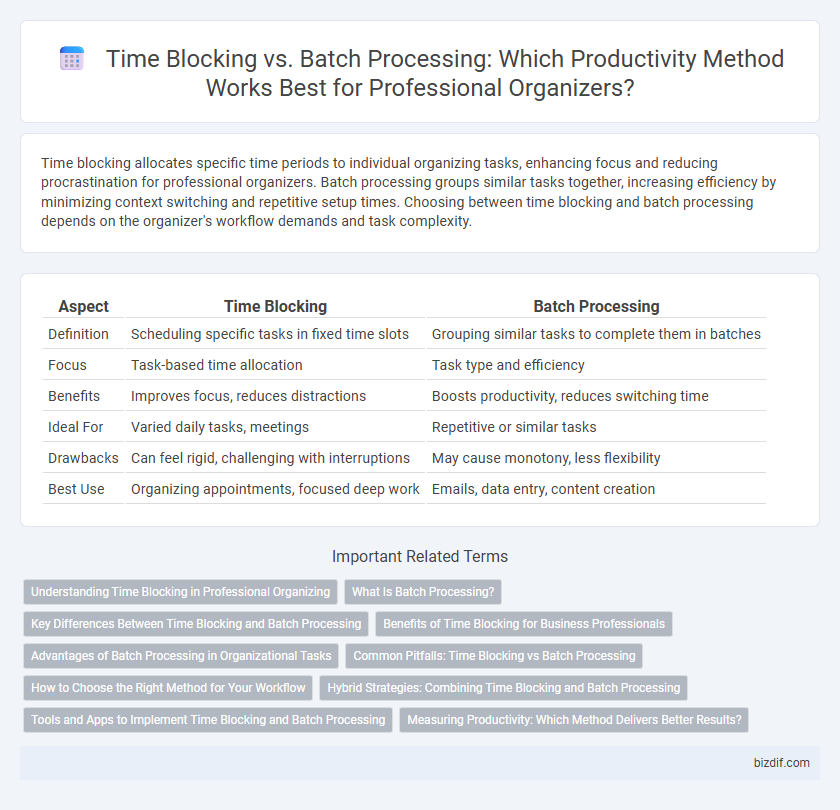Time blocking allocates specific time periods to individual organizing tasks, enhancing focus and reducing procrastination for professional organizers. Batch processing groups similar tasks together, increasing efficiency by minimizing context switching and repetitive setup times. Choosing between time blocking and batch processing depends on the organizer's workflow demands and task complexity.
Table of Comparison
| Aspect | Time Blocking | Batch Processing |
|---|---|---|
| Definition | Scheduling specific tasks in fixed time slots | Grouping similar tasks to complete them in batches |
| Focus | Task-based time allocation | Task type and efficiency |
| Benefits | Improves focus, reduces distractions | Boosts productivity, reduces switching time |
| Ideal For | Varied daily tasks, meetings | Repetitive or similar tasks |
| Drawbacks | Can feel rigid, challenging with interruptions | May cause monotony, less flexibility |
| Best Use | Organizing appointments, focused deep work | Emails, data entry, content creation |
Understanding Time Blocking in Professional Organizing
Time blocking in professional organizing involves dedicating specific, uninterrupted periods to individual tasks, enhancing focus and productivity. This method reduces multitasking and helps maintain a clear schedule, making it easier to track progress and allocate resources effectively. By structuring the day into defined slots, time blocking supports mental clarity and prioritization essential for efficient organization.
What Is Batch Processing?
Batch processing in professional organizing involves grouping similar tasks together and completing them consecutively to maximize focus and efficiency. Unlike time blocking, which schedules specific time slots for varied activities, batch processing reduces cognitive switching by concentrating on one category of tasks at a time. This method enhances productivity by minimizing interruptions and streamlining workflow for activities like sorting, decluttering, or paperwork.
Key Differences Between Time Blocking and Batch Processing
Time blocking involves scheduling specific tasks into fixed time slots on a calendar to enhance focus and minimize distractions. Batch processing groups similar tasks together to be completed consecutively, reducing the cognitive load of switching between different activities. Key differences include time blocking's emphasis on precise timing and structure, while batch processing prioritizes task similarity to maximize efficiency.
Benefits of Time Blocking for Business Professionals
Time blocking enhances productivity for business professionals by allocating specific time slots for focused tasks, reducing distractions and improving workflow efficiency. This method supports better time management and prioritization, leading to increased task completion rates and reduced procrastination. By structuring the workday, time blocking also minimizes decision fatigue and helps maintain consistent energy levels throughout business hours.
Advantages of Batch Processing in Organizational Tasks
Batch processing streamlines organizational tasks by grouping similar activities, reducing transition time and cognitive load. This method enhances focus and efficiency by allowing uninterrupted attention on one type of task, leading to faster completion and higher quality results. Teams benefit from batch processing through improved consistency and easier prioritization of workflow.
Common Pitfalls: Time Blocking vs Batch Processing
Common pitfalls in time blocking include underestimating task duration and over-scheduling, leading to frequent interruptions and missed deadlines. Batch processing struggles arise from grouping incompatible tasks, causing reduced focus and increased cognitive switching costs. Both methods require precise task categorization and realistic time allocation to optimize productivity in professional organizing.
How to Choose the Right Method for Your Workflow
Assess your daily tasks to determine whether time blocking or batch processing enhances your productivity; time blocking suits individuals needing structure with scheduled focus periods, while batch processing benefits those handling repetitive tasks by grouping similar activities. Consider the nature of your work, deadlines, and energy levels to match the method that reduces context switching and maximizes efficiency. Experiment with hybrid approaches to tailor time management strategies to your unique workflow demands, leveraging tools like digital calendars or task management apps for optimal results.
Hybrid Strategies: Combining Time Blocking and Batch Processing
Hybrid strategies in professional organizing integrate time blocking and batch processing to maximize productivity by allocating specific time slots for grouped tasks. This approach enhances focus and reduces cognitive switching, leading to improved task completion rates and efficient workflow management. Utilizing calendar tools like Google Calendar or Microsoft Outlook can streamline hybrid scheduling and maintain consistency.
Tools and Apps to Implement Time Blocking and Batch Processing
Time blocking and batch processing can be effectively implemented using tools like Google Calendar, Todoist, and Trello, which allow users to visually segment tasks and set focused work periods. Apps such as Clockify and RescueTime help track time spent on specific blocks, enhancing accountability and productivity during batch processing sessions. Utilizing these digital tools streamlines task management and maximizes efficiency in professional organizing workflows.
Measuring Productivity: Which Method Delivers Better Results?
Time blocking structures the day into distinct periods dedicated to specific tasks, enhancing focus and minimizing distractions, which often leads to higher quality outputs. Batch processing consolidates similar tasks to reduce transition time, increasing efficiency but potentially sacrificing depth of engagement for complex activities. Evaluating productivity depends on task complexity and individual work styles, though time blocking generally delivers better results for creative or strategic work, while batch processing excels in repetitive or administrative tasks.
time blocking vs batch processing Infographic

 bizdif.com
bizdif.com